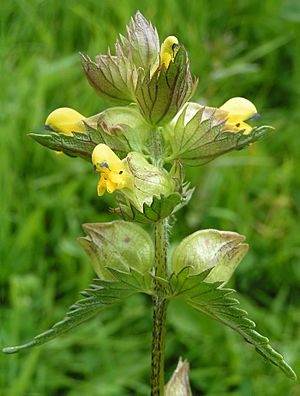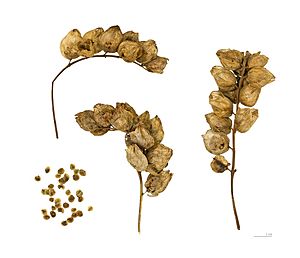Yellow rattle facts for kids
Quick facts for kids Yellow rattle, cockscomb |
|
|---|---|
 |
|
| Scientific classification | |
| Genus: |
Rhinanthus
|
| Species: |
minor
|
The Yellow Rattle (scientific name: Rhinanthus minor), also known as little yellow rattle or cockscomb, is a fascinating flowering plant. It belongs to the Rhinanthus group in the Orobanchaceae plant family. You can find it growing naturally across Europe, northern North America, and Western Asia.
This plant is a special kind of hemi-parasitic herbaceous plant. This means it's mostly green and leafy, and it gets some of its food and water by connecting to the roots of other plants nearby. It's an annual plant, which means it grows, flowers, and dies within one year.
Yellow Rattle plants usually grow to be about 25 to 50 centimeters (10 to 20 inches) tall. They have simple leaves that grow opposite each other on the stem, and their edges look like they have small teeth (serrated). The flowers are bright yellow and grow in a cluster at the top of the stem.
After the flowers, the plant produces dry seed capsules. When these capsules are ripe, the seeds inside become loose and rattle if you shake them. This is how the plant got its name – Yellow Rattle! You'll often find these plants in dry fields or meadows. They usually flower between June and September. Yellow Rattle can connect to many different types of plants, especially Poaceae (grasses) and Fabaceae (legumes, like peas or beans).
Contents
Why Yellow Rattle is Important
In places like Ireland and Scotland, Yellow Rattle is often found in a special type of coastal grassland called Machair. This plant plays a very important role in keeping these areas healthy.
Scientists at the UK's Centre for Ecology and Hydrology have found that if you encourage Yellow Rattle to grow in hay meadows, it helps many other plant species thrive. It does this by slowing down the growth of strong grasses. This gives other, smaller plants more space and sunlight to grow, which makes the meadow much more diverse and full of different kinds of plants. The seeds of Yellow Rattle are easily spread when people cut hay in the traditional way.
How to Grow Yellow Rattle
If you want to help Yellow Rattle grow, it's not too hard! First, gently scratch the surface of the ground with a fork. Then, sprinkle the seeds onto short grass. You'll need about 0.5 to 1 gram of seeds for every square meter (about 10 square feet).
It's important to know that Yellow Rattle seeds don't last long, so you should always plant them in the autumn, using seeds that were collected that same year. After planting, keep the grass short until early March, which is when the new Yellow Rattle seedlings start to grow. After that, don't cut the grass until the end of July. This allows the Yellow Rattle plants to flower and produce their own seeds. Once they've dropped their seeds, you can cut the grass short again.
What's in a Name?
The scientific name Rhinanthus comes from ancient Greek words. "Rhino" means 'nose', and "anthos" means 'flower'. This name was chosen because the top part of the flower (called the corolla) looks a bit like a nose. The second part of the name, minor, simply means 'smaller'.
Images for kids
See also
 In Spanish: Cresta de gallo para niños
In Spanish: Cresta de gallo para niños




